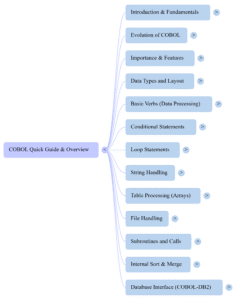
- Instructor: Alice Bianchi
- Lectures: 51
- Students: 22654
- Duration: 10 weeks
The provided course offers an extensive guide to COBOL programming, detailing its history as a high-level, business-oriented language developed in the late 1950s. The guide meticulously covers environment setup and fundamental concepts such as data types and the use of the Picture Clause for defining data attributes. A significant portion of the material focuses on COBOL verbs—including basic operations like ADD, SUBTRACT, MOVE, and DISPLAY—along with complex control flow structures like conditional statements (IF, EVALUATE) and loop statements (PERFORM). Furthermore, it explains advanced topics such as string handling, defining and manipulating tables (arrays) using OCCURS, and comprehensive file handling methodologies, including different file organisations, access modes, and associated file handling verbs. Finally, the text introduces interfacing COBOL programs with DB2 databases using embedded SQL, host variables, and cursors.
COBOL programming Course is based on textbook learning material by Academy Europe.

Study Hard AND Study Smart!
Dear Students,
The textbook courses by Academy Europe are targeted at providing the students with the most important aspects of the theoretical and methodical materials. In addition, the textbook courses will also focus on the philosophical background for the development and use of the theoretical background and are thus to be understood as partly complementary to the material of the course notes. It is assumed and strongly suggested that the students study and become familiar with the course notes.
Empower Academy Europe
Join Academy Europe social media channels on Youtube, Facebook, Linkedin, Twitter and more. Share and like them by using your social media accounts.
Facebook: www.facebook.com/academyeurope
Twitter: https://twitter.com/academyeurope
Youtube: www.youtube.com/c/academyeurope
Linkedin: https://www.linkedin.com/company/academy-europe/
Certification
Academy Europe presents high-quality formal diplomas, certificates and e-certificates which are formal proof and recognition of accredited online courses. It shows all student’s abilities to learn and achieve high results and is very useful to promote personal career including with CVs, job applications and self improvements.
Samples: Horizantal Diploma – Horizantal Certificate – Vertical E-Certificate



How can you get your certificate at Academy Europe?
- You must click “complete” link at the end of every lesson of your course after you finish them.
- When you finish all lessons of course, the “finish course” link is going to be active at the end of last lesson.
- When you click the “finish course” link, you will finish your course on Academy Europe officially. Then, “certificate” page of you completed course will be automatically active.
- You can see and download your certificate online after you click on your “certificate” link.
Audience
This course by Academy Europe aims at imparting quality education and training to students.
Academy Europe is dedicated to its students, their specific learning requirements, and their overall learning success.
This course is directed toward a student-centered, independent study, asynchronous learning approach.
After completing this course on Academy Europe, students will get self improvement and promotion in their careers.
This course is based on at least two learning skills which are provided to the users through audio & visuals, videos, verbal presentations and articles, all of which are asynchronized with distance education approach.
Prerequisites
Before you start proceeding with this course on Academy Europe, we are assuming that you have a good aptitude and can think logically. You should want to try something different.
Ideal candidates for the course would typically possess:
– Discipline and attentiveness
– Ability to conduct research
– Ability to perform tasks with speed, efficiency, and accuracy
– Analytical judgment
– Patience to interpret technical/scientific data
– A willingness to learn, roll up your sleeves and work toward your dream!
– A computer, tablet or smartphone and an internet connection
– Basic computer skills
Curriculum
- 8 Sections
- 51 Lessons
- 10 Weeks
- Introduction1
- COBOL Programming Language: A Comprehensive Briefing10
- 2.1Executive Summary
- 2.21. Introduction and Core Concepts
- 2.32. Data Definition and Layout
- 2.43. Core Procedural Verbs and Statements
- 2.54. Control Flow and Logic
- 2.65. Data Structures: Table Processing
- 2.76. File Handling
- 2.87. Modularity and Code Reusability
- 2.98. Advanced Data Processing: Sorting and Merging
- 2.109. Database Interface (COBOL-DB2)
- Academic Lecture Notes: A Comprehensive Study of COBOL for Enterprise Systems10
- 3.11.0 Introduction to COBOL: A Legacy of Business Computing
- 3.22.0 The Anatomy of a COBOL Program: Structure and Syntax
- 3.33.0 Core Procedural Logic: Essential COBOL Verbs
- 3.44.0 Advanced Data Definition and Layout
- 3.55.0 Controlling Program Flow: Logic and Iteration
- 3.66.0 Advanced Data Manipulation: Strings and Tables
- 3.77.0 File Handling: The Heart of Business Data Processing
- 3.88.0 Program Modularity: Subroutines and the Verb
- 3.99.0 Advanced Processing: Internal Sorting and Merging
- 3.1010.0 Bridging the Gap: The COBOL-DB2 Database Interface
- A Technical Whitepaper on the COBOL Programming Language: Principles and Practices9
- 4.11.0 Introduction to COBOL: An Enduring Legacy in Business Computing
- 4.22.0 Fundamental Data Structures and Definitions
- 4.33.0 Core Procedural Verbs for Data Manipulation
- 4.44.0 Control Flow and Logical Operations
- 4.55.0 Advanced Data Handling: Strings and Tables
- 4.66.0 Persistent Data Management: File Handling
- 4.77.0 Modern Data Integration: Database Interfacing with DB2
- 4.88.0 Program Structure and Modularity
- 4.99.0 Conclusion
- COBOL Operations Handbook: A Practical Guide to File and Data Manipulation6
- 5.11.0 Introduction: The Foundation of Mainframe Data Processing
- 5.22.0 Understanding COBOL File Structure: The Building Blocks
- 5.33.0 Core Principles of File Organization
- 5.44.0 Mastering File Access Modes
- 5.55.0 The COBOL File Handling Verbs: An Operational Guide
- 5.66.0 Advanced File Processing: Sorting and Merging
- Your First Steps in COBOL: A Beginner's Guide7
- 6.11. Welcome to COBOL! What It Is and Why It Matters
- 6.22. The Anatomy of a COBOL Program: The Core Divisions
- 6.33. Defining Your Data: The Clause
- 6.44. Making Things Happen: Essential COBOL Verbs
- 6.55. Making Decisions with
- 6.66. Putting It All Together: Your First Program
- 6.77. Conclusion and Next Steps
- A Beginner's Guide to Controlling Program Flow in COBOL4
- COBOL Concepts Study GuideThis guide provides a comprehensive review of key concepts in the COBOL programming language, based on the provided source material. It includes a short-answer quiz with an answer key, a set of essay questions for deeper analysis, and a detailed glossary of terms.4
Requirements
- Discipline and attentiveness
- Ability to conduct research
- Ability to perform tasks with speed, efficiency, and accuracy
- Analytical judgment
- Patience to interpret technical/scientific data
- A willingness to learn, roll up your sleeves and work toward your dream!
- A computer, tablet or smartphone and an internet connection
- Basic computer skills
Features
- Before you start proceeding with this course on Academy Europe, we are assuming that you have a good aptitude and can think logically. You should want to try something different.
Target audiences
- This course by Academy Europe aims at imparting quality education and training to students.
- Academy Europe is dedicated to its students, their specific learning requirements, and their overall learning success.
- This course is directed toward a student-centered, independent study, asynchronous learning approach.
- After completing this course on Academy Europe, students will get self improvement and promotion in their careers.
- This course is based on at least two learning skills which are provided to the users through audio & visuals, videos, verbal presentations and articles, all of which are asynchronized with distance education approach.





